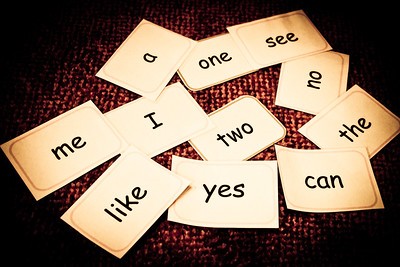Sight Word Spectacular
 As mentioned before, Kirby believes that teaching sight words and phonetics together is the best way to set kids up for a future of reading well. In this post, we'll cover some sight word games to play and the words to use when making these games.
As mentioned before, Kirby believes that teaching sight words and phonetics together is the best way to set kids up for a future of reading well. In this post, we'll cover some sight word games to play and the words to use when making these games.
When making your own sight word cards, it is important for us to start by mentioning that young eyes need the sight words written very largely (1-2 inches high). The muscles of young eyes are learning how to focus on things. Another helpful tip is to write mainly in lower case letters on pieces of cardboard or another sturdy card paper.
In choosing which words to begin with, use the names of family members including the child's name with upper and lower case letters. Write the child's name, then Mama (use upper and lower case m with Mama to make it easier), and the names of others who are around a lot. Once these are written on a card, lay them out on the table and pick them up several times throughout the day and say the word that is on the card. Depending on the child's level of interest, this will take varying amounts of time to stick with them- they will learn in their own time. This is a no-pressure, fun way to learn. Eventually, they will say the word before you when they see which one you are about to pick up and then you'll know they have it. This is when you add a new word to the table, keeping the first word in the mix, and so on.
Types of words to use:
Names - If everyone's names look similar, only do Mom, Dad, and the child's name.
Body parts - Do not use head & hand back to back because the visual form of these words is so similar.
Verbs - Short action words such as: go, run, etc.
Once a child has a few sight words memorized, take these cards and place them on the floor to be mixed up. Then the object is to make funny sentences and read them together (in whatever order the child puts them). The main point is to keep things light with no pressure and to have fun! Help the child with any words they cannot remember and remember- giggling is very important!
As soon as you get to this stage, let them use these words to let them write their first story. The child arranges the words and the adult writes it down, then the child reads their story to the adult. This would be a good time to bring home early reader books from the library (and use these books as a resource to find new sight words to write down and add to the cards you have). Read these books to them and then, after practicing their new sight words, they can read to you. Choosing books that have rhyming words helps new readers to remember new words.
Eventually word families will come about and these can be used to make simple stories such as: "The rat sat on the mat." The child can make these stories themselves and read them back to the adult as with the sight word mix up described above. The next step after these stories would be to begin to help the child learn how to write these words they know.
In all these activities, we will repeat: it is vital (so important that this blog is named for it) that there is no pressure but that these games are kept fun and delightful to the child. Growth AND giggles!
Note: Many of these ideas have been formed after reading the book How To Teach Your Baby To Read.
Photo Credit: Susana Fernandez cc
Related Posts
By accepting you will be accessing a service provided by a third-party external to https://growthandgiggles.com/